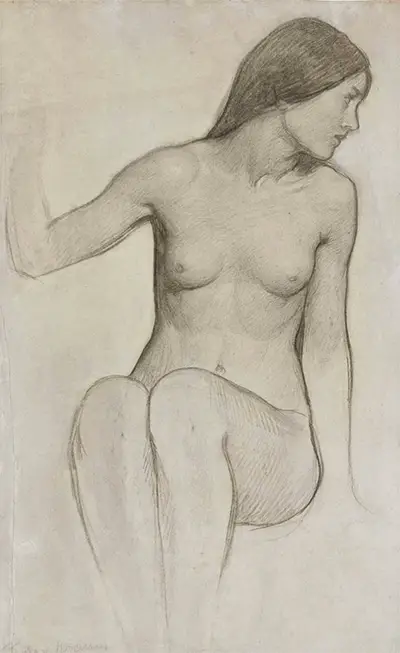The composition features a tall, slim woman with long brown hair which hangs behind her shoulders. Her figure is impressive and entirely in keeping with the artist's normal preference for his models. It is likely that someone as striking and suitable as this would have featured in a number of his drawings and paintings as Waterhouse re-used his favourite models across a variety of projects. She sits with her modesty covered, and her legs together whilst looking out to the right hand side. Her left hand helps her to keep her balance whilst her right arm is lifted up, though the hand is not completed in this drawing. One immediately imagines that in the final painting her right hand will be completing an important role but in the case of this study, Waterhouse is focused more on the lady's figure and also the angled neck which peers away from us. His study drawings were normally of portraits, all fairly similar to this, as he understood the importance of practice when it came to drawing portraits accurately.
Echo and Narcissus must surely have been a critical artwork in the eyes of its creator because of how here he produced a full length study, one of several, when normally he would work from a small sketchbook and focus only on elements of the model, leaving the rest blank. One can see from the final painting that he did not go too far from what we see in this drawing, although the clothing was added at that later date. Here he intends only to concern himself with the model's figure and understand what lied beneath the clothing. The content used in this series of artworks comes from Greek mythology which would also lay behind a number of other key paintings by this artist. He would also call upon British poetry for inspiration elsewhere and the two together would be the base of a large proportion of his oeuvre.
The piece is 79cm tall and 46cm wide, making it one of his largest drawings. It is listed as having been completed on blue-grey paper, which is also slightly unusual for this artist. Waterhouse became inspired by the Pre-Raphaelites and would work in a similar way but because of his relative youth, some do not consider him to have been a genuine part of the group - he was approximately two decades younger than the likes of Morris, Holman Hunt and Burne-Jones. These great names would produce creative items across a wide range of different disciplines, eventually forming their own companies which attempted to protect the original methods of design in the face of increased industrialisation. They boasted a supreme level of integrity and commitment to continuing to do things the right way, as they saw it. Such ideas have enjoyed popularity in recent years as we all start to see an even greater use of automised production techniques which tend to output cheaper, low quality items that would not be to everybody's taste.

